This past weekend we spent 24 hours with a large group of dedicated and enthusiastic science-minded folks at the White Memorial Bioblitz. What is a bioblitz? It's a 24 hour event that tallies every species inhabiting a study site. Biologists blitz the area in search of every living species, and the bioblitz finishes with a final count of all the species discovered. There were bird people, fish people, plant people, lichen people, bug people, and we were part of the fungus working group, along with some other members of CVMS, the Connecticut Valley Mycological Society. The final count for the kingdom Fungi was 89 specimens, and the final count of all species of life was 931 species.
The end of May and very beginning of June are not terribly exciting times of the year for finding fungi in Connecticut. We mostly collected wood decaying fungi and several slime molds, but fellow myco-nuts Emily and Mike did surprise us all and found 3 beautiful morels on site. They were greatly admired specimens.
 |
| CVMS Fungi display and one of our club experts, Terry |
Some of our better-looking fungi were brought over to the Tree of Life Museum, along with some informational sign boards. Some of our finds included lots of turkey tails (Trametes versicolor and Trametes hirsuta), the platterful mushroom (Megacollybia rodmanii), the blonde morels (Morchella esculentoides), winecaps (Stropharia rugosoannulata), and a few slime molds including dog vomit (Fuligo septica), chocolate tube slime (Stemonitis), and Ceratiomyxa, which was incredibly abundant that weekend. Also on display at the other tables were assorted ferns, some caterpillars, fish, flowers, lichens, moss, and some stuffed animals from the White Memorial Museum.
Robert took some photographs of something we could not at first identify. It looked like yellow tapioca beads on some decayed wood. If the tapioca beads were white, we would identify them as Stemonitis species in their plasmodial stage. Left to age overnight, we were greeted by the wet "chocolate" stage, the fruit body, or sporangia, of the slime mold. Later that day, we dispersed the spores by gently blowing on the strands, leaving the structures that held the spores behind. This is a great species that Robert would like to time-lapse photograph, so we'll keep our eyes open for more of the "tapioca" stage slime. Slime molds are not in the kingdom Fungi, but we often collect and identify them while on forays.
 |
| Stemonitis in three stages |






No comments:
Post a Comment